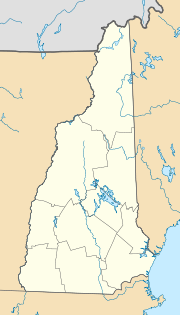Wolfeboro
| Wolfeboro | ||
|---|---|---|
|
Location in New Hampshire
|
||
| Basic data | ||
| Foundation : | 1770 | |
| State : | United States | |
| State : | New Hampshire | |
| County : | Carroll County | |
| Coordinates : | 43 ° 35 ′ N , 71 ° 13 ′ W | |
| Time zone : | Eastern ( UTC − 5 / −4 ) | |
| Residents : | 6,269 (as of 2010) | |
| Population density : | 50.1 inhabitants per km 2 | |
| Area : | 151.5 km 2 (approx. 58 mi 2 ) of which 125.1 km 2 (approx. 48 mi 2 ) is land |
|
| Height : | 156 m | |
| Postal code : | 03894 | |
| Area code : | +1 603 | |
| FIPS : | 33-86420 | |
| GNIS ID : | 0873760 | |
Wolfeboro is a city in Carroll County in the state of New Hampshire in the United States . The neighboring Wolfeboro Falls also belongs to Wolfeboro. The population of the two places rose from 6,083 in 2000 to 6,269 in 2010, with Wolfeboro itself only having 2,838 inhabitants. Lake Winnipesaukee is near the city . The city is called "America's Oldest Summer Resort".
history
Early history, Winnipesaukee
The area of the lake was continuous from the 8th millennium BC. Inhabited. The Winnipesaukee, after which the lake is named, counted over 400 relatives in 1614 who visited various camps, including one at Wolfeboro Falls. Their winter village Aquadoctan or Aquedaukenash (The Weirs) was on the lake. Smallpox epidemics , fights that flared up again and again for decades between the Abenaki , to whose western branch the Winnipesaukee belonged, the Mohawk , but especially between the French and the British, decimated their numbers so much that in 1696 the few remaining families on Lake Winnipesaukee left their village Aquadoctan . They joined the Pequaket tribe on the Saco River near today's Fryeburg in Maine .
British colonial times, US independence
The town was given to four men from Portsmouth by British governor Benning Wentworth in 1759 and was named after the English general James Wolfe , who had defeated the French in 1759 off Québec. In 1763, 930 hectares were added to the 24 hectares already reserved for the governor. In 1768 the first settlers came, and in 1770 the small settlement was incorporated. John Wentworth, the governor's nephew, built an estate there called Kingswood in 1771 . This was New England's first summer home, the marketing industry claims, but it became a fire in 1820. The governor hardly wanted to usher in the tourism era, but rather stimulate economic development in the remote corner. In addition, towards the end of the American Revolution he had to leave the United States as a loyalist and go to Canada, which remained British. His property, often referred to as the "plantation", was still unfinished at that time.
Oldest building, school
The oldest surviving building in Wolfeboro was built in 1778. It is the main building of a farm that stretched between South Main Street and the shores of Lake Winnipesaukee . Joseph Clark bought the house in 1817 from the Evans widow, who had run an inn there, ie operated a bar with overnight accommodation. Clark was a cabinet maker from Greenland , not far from Portsmouth . In 1917 the Clarks donated the building to the Town of Wolfeboro , but the barn was moved to the nearby Goodrich Road.
In 1805 the first school was built in the Pleasant Valley in South Wolfeboro, which, as was customary, was named Pleasant Valley School after its location . The school was later named Townsend School , with between 25 and 50 students , because the building was located near the home of Reverend Isaac Townsend, the first priest to work in Wolfeboro. In 1959 she was transferred to the Clark Museum Complex .
In 1820, today's Brewster Academy boarding school was founded. Initially it was called Wolfeboro & Tuftonboro Academy , from 1887, in honor of a founder named John Brewster, Brewster Free Academy . As of 1964, the Academy was the only high school in Wolfeboro.
tourism
With The Pavilion 's first major hotel, the others followed was the 1850th When Mount Washington was launched in 1872, tourists also came across the lake.
Historical and archaeological research
In 1925 the Wolfeboro Historical Society was founded, which rented the Clark House; In 1959 it was moved to its current location. A barn from the 1840s was built there after 2006.
In 1934 and 1935 the first excavations were carried out on the Wentworth estate, the results of which the tourism industry used for an advertising campaign.
literature
- Benjamin Parker: History of Wolfeborough, NH , 1901. (The 545-page work deals primarily with the early settlers)
- Q. David Bowers: History of Wolfeboro , 3 vols., 1994. (Continued with Parker)
Web links
- Wright Museum of WWII History
- Libby Museum ( Memento from September 12, 2015 in the Internet Archive ) (founded in 1912)
- New Hampshire Boat Museum
- Wolfeboro Historical Society
- Wentworth State Park
Remarks
- ↑ This is what David Starbuck claimed: America's First Summer Resort. John Wentworth's 18th Century Plantation in Wolfeboro, New Hampshire , in: The New Hampshire Archaeologist 30.1 (1989), passim.
- ↑ Mark P. Leone, Parker B. Potter Jr .: Historical Archaeologies of Capitalism , Springer 1999, p. 78.
- ^ David R. Starbuck: The Archeology of New Hampshire. Exploring 10,000 Years in the Granite State , 2008, p. 104.



